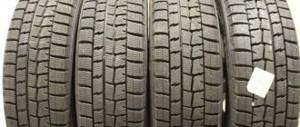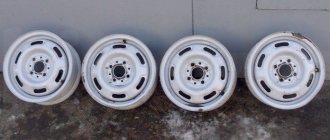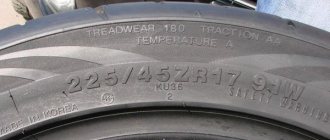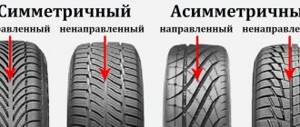When is it legal to change tires for winter ones in 2020 in Moscow and other Russian cities? From what date and month? Recommendations from the traffic police.
Winter in Russia, as always, creeps up unexpectedly. And although September is just ending, many are already looking for information on when to change tires to winter ones.
Many people do not know that the timing of the transition to winter tires in Russia is now established by law. When is it better to change your car's shoes for the winter in 2020 - recommendations from weather forecasters and the traffic police.
When is it legal to change summer tires to winter tires in 2020?
Many still do not know that on January 1, 2020, the Technical Regulations of the Customs Union “On the safety of wheeled vehicles” came into force. This document contains Appendix No. 8, which sets out the legal requirements for tire seasonality. According to the regulations, in winter (December, January, February) winter tires must be installed on the car. That is, according to the law, you need to change tires to winter ones no later than December 1, 2020. Even fewer people know that there is no fine for failure to change tires in Russia yet. However, on December 1, winter is already in full control over most of Russia, so when changing tires you should be guided by common sense, and not regulations.
When should you change your car to winter tires in 2020? - recommendations from weather forecasters
Forecasters recommend installing winter tires when the average daily temperature drops below +7 degrees. At these temperatures, summer tires become hard and their properties deteriorate. In principle, this is quite reasonable. It is also worth paying attention to the weather forecast. If it’s warm outside now, and the weather forecast predicts temperatures below zero for the entire next week, then you can think about changing your car’s shoes this coming weekend.
When should you change tires in 2020?
During the change of seasons, one interesting meteorological feature is observed: when the thermometer shows +5 degrees or less, then precipitation, no matter what its type is indicated in the weather forecaster, as a rule, already occurs in the form of snow and ice grains.
This means that icy conditions will not be long in coming. So drivers should be very attentive to the condition of the road surface, especially in the morning, in order to change tires on time.
It is prohibited to drive a car with summer tires on asphalt covered with an icy crust. In turn, a winter set of tires will be appropriate only at +5 degrees Celsius and below.
In winter, only winter tires are allowed. You can also install studded or all-season tires, which are marked with the letters “M+S”, “M&S” or simply “MS”. In this case, a mandatory condition must be met: the tread depth is at least 4 mm.
The laws stipulate that the minimum mandatory service life of winter tires is three winter months: December, January and February. At the same time, the authorities of each individual region can extend it, for example, by adding November or March. Local officials do not have the right to reduce this period.
Table of permissible periods of use of various types of rubber by month:
Traffic police officers note: in accordance with traffic rules, it is prohibited to simultaneously install studded and non-studded tires on a vehicle. This combination can cause the vehicle to behave unexpectedly while driving.
It is also prohibited to operate a vehicle if there are tires on the same axle that differ in size, type, tread pattern or degree of wear. The last criterion requires especially careful attention.
Every driver should know that the best value for the tread depth of winter tires is 8 mm. If it is reduced by at least 2 mm, the braking distance becomes longer by 20%, and if the tread depth is reduced to 4 mm, then by as much as 70%.
When to change tires to winter ones: “It’s a pity for the studs, but it’s even more of a pity for the car”
“Tires need to be changed now,” says Alexey Nosov, executive secretary of the Auto Moto Association (AVAMT). – Summer tires lose their properties when the average daily temperature reaches plus 7. If the temperature drops below, summer tires stop working, they lose their grip. Summer tires are designed to operate at higher temperatures, which is why their composition is tougher.
Regardless of whether there is snow and ice on the road or not, at temperatures below 7 degrees you need to change to winter tires. The best indicator when this needs to be done is to turn on the heating in houses.
After all, this happens precisely at this average daily temperature. The batteries are getting warmer - put on summer tires!”
06.10.2017
The fear of the tinsmith's day began to haunt Novosibirsk residents
Aleksey Erushev, a tire repair shop foreman, recommends changing summer tires to winter tires as soon as the daytime temperature drops below +10 degrees Celsius. At this temperature, summer tires lose their elasticity and become slippery.
Summer tires lose their properties and “harden” at low temperatures, which can, at a minimum, significantly increase the braking distance or provoke an uncontrolled skid.
Judging by the forecasts of the hydrometeorological center, it is time to change the tires now. “In some northern regions of the Novosibirsk region there is already precipitation, we assume that on October 6 we may fall into the precipitation zone mainly in the form of wet snow, tomorrow we expect the temperature to drop at night to minus 7, in some places to minus 12 degrees,” he told the correspondent VN.ru press secretary of the Novosibirsk hydrometeorological center Renad Yagudin.
On October 5, the Russian Ministry of Emergency Situations on the website of the regional administration published a call to car owners and pedestrians to be extremely careful and attentive during this unfavorable period: “Precipitation in the form of rain and sleet and sub-zero temperatures at night will contribute to the formation of ice, in places there will be fog in the region and poor visibility . On intercity routes, traffic conditions can be especially difficult.”
05.10.2017
Tinsmith Day 2017 in Novosibirsk: weather forecasters announced the date
“We need to start changing summer tires to winter ones now. Due to the possible sudden cold snap, the driver’s main task is to have time to prepare the car before ice or snow appears. The properties of modern winter tires do not change when used in warm weather, and the tires do not wear out significantly. Remember, if the tires of your car are not suitable for the weather, it is dangerous to drive it,” the traffic police of the neighboring Altai Territory recommend. According to forecasters, the first snow is expected in the Altai Territory this weekend.
Changing your car's shoes in time is a matter of safety for the driver, passengers and surrounding vehicles on the highway. But there are car owners who wait until the last minute, explaining this by the desire to preserve the service life of winter tires, in particular, studs. Experts do not share this position. “It’s a pity for the spikes, but it’s even more of a pity for the car, and even more so for the pedestrian at the pedestrian crossing,” says Alexey Nosov.
“According to long-term statistics, you can count 20 days after the first snow and feel free to change your shoes,” says installation manager Sergei Izosimov. – You can wait for the snow to fall after this date, and be sure that it will definitely not melt (thaws, when there is no snow until December, are not taken into account - we grit our teeth and ride on spikes).
Another topic of debate among car enthusiasts flares up every autumn: which is better – studded tires or winter tires without studs? According to the results of the drom.ru survey, studded tires won: 47% for them versus 40% for Velcro tires.
Debates on the forum of the same resource, as a rule, end in favor of winter tires with studs, at least in Siberia, as well as the specifics of traffic.
If the car is operated in the “home-office-shop” mode in a city where the roads have a small layer of snow and are also sprinkled with sand, then you can “shod” the car in non-studded winter tires. Studded tires are indispensable for frequent trips outside the city on ice-encrusted roads. But in Novosibirsk in winter, city highways are not always cleared down to asphalt; they are often covered with ice. Accordingly, the choice is in favor of spikes.
Law on winter tires: adopted or not
The requirements and recommendations of the Technical Regulations of the Customs Union, which refer to the safe use of wheeled vehicles, began to apply in 2020. In particular, they contain clauses with mandatory requirements for tires.
According to the information provided, cars must be fitted with winter tires throughout the entire winter period (3 months), and in the summer, respectively, with summer tires. The winter period is the time from December 1 to March 1 (in some regions of the Russian Federation the period may be extended), and the summer period is from June 1 to September 1.
At the same time, at the moment there is no mention of any penalties for failure to comply with this requirement in the laws of the Russian Federation. A bill to introduce fines for driving on summer tires in winter was submitted to the State Duma in the fall of 2020, but it is still in limbo.
Why is it necessary to change summer tires on wheels to winter ones?
All motorists know: in winter you need to drive on winter tires, and in summer - on summer tires. This is a safety issue that should never be neglected. So, with the arrival of cold weather, tire fitting services are literally occupied by drivers. There is no way to avoid this.
In summer, driving on tires designed for winter use is not recommended. This rubber has a different composition, so the treads of such wheels quickly become unusable on hot asphalt in dry weather. In addition, such rubber has poor grip in warm weather and a much longer braking distance.
Summer tires have different properties. It will not provide safety when driving on snowy or icy road surfaces. But in the warm season, it shows itself perfectly, maintaining confident grip on the road, not wearing off, and draining water due to special gutters that are located on the tread surface.
There are also so-called all-season tires. But experienced motorists don't like it. This can be compared to treating all diseases with one tablet. The desired effect will not be achieved in the end. It is equally ineffective in both winter and summer. Therefore, you need to change your car in time to the exact tires that are needed for this season.
Penalty for summer tires in winter
The provision of the Customs Union banning the use of summer tires in the winter season was approved two years ago, but it has not yet been reflected in the Administrative Code. Those. Formally, no penalties or fines are provided for violating the requirements for the timing of installation of a winter set of tires.
However, drivers should not forget that the traffic police officer has the right to issue a fine for worn tires, which currently amounts to 500 rubles, or, at best, issue a simple warning.
Thus, from the beginning of December, all cars on Russian roads must be “re-shod.” But, most likely, weather conditions will force motorists to change their tires to winter ones much earlier
The answer to this question is simple, but requires the driver to pay increased attention to the weather forecast.
Many experts argue that winter tires must be installed when the average daily temperature reaches approximately +7 degrees . This answer can be considered the most correct, but is it worth rushing when the autumn frost has not become stable?
For example, what to do in weather conditions when the temperature at night can be about 1-5 degrees below zero, and during the day it rises to +15.
At such daytime temperatures, the wear of winter tires will be increased, but the most dangerous thing is the behavior of the rubber on warm asphalt, which will simply begin to float.
It is the last factor that is decisive, since the braking distance of a car on Scandinavian-type winter tires in warm weather can increase by several meters.
In this regard, we can conclude that there is no need to rush to install winter tires if the weather forecast does not promise stable negative temperatures at night and in the morning for a long time.
It is necessary to understand that when the temperature drops below zero, you need to monitor the condition of the road surface very carefully. If there was precipitation the day before, you shouldn’t go out on the road, since summer tires are completely helpless on ice. Was there fog at night and frost in the morning? In this case, you should leave the car at home, as a thin, lumpy crust of ice may form on the road, which is dangerous for any tires, especially summer tires.
The intermediate conclusion is as follows: if you use your car frequently and leave early in the morning, then it is better to install winter tires a little earlier than stable winter weather arrives. If you leave home late in the morning, when the air has already warmed up to positive temperatures, then stay in the summer. If the weather forecast predicts a stable cold snap, you can install winter tires even in relatively warm weather to get used to their behavior. If you use European-type winter tires (for mild winters), then feel free to install them in advance.
General recommendations for installing winter tires
Keep an eye on the long-term weather forecast. If two days of cold weather are followed by two weeks of warm weather, it is better to leave summer tires on the car and be especially careful during these two days of cold weather. Don't take risks and don't go out on the road with summer tires if it's frosty outside. This is especially true for those who travel a lot at night and in the morning!
When do you need to replace summer tires with winter ones?
There is a certain rule when this should be done. Changing tires on wheels depends on the average daily temperature. Thus, the properties of summer tires will be lost after the air temperature drops below +5 C. That is, when it is observed that the temperature has settled at this level, you should go to a car service center and replace the wheels.
It is impossible to accurately name the date of tire replacement, since Russia has several latitudes, each of which has its own temperature. In some regions, motorists change their shoes at the beginning of September, while in others they can safely drive on summer tires until the end of November.
The use of winter tires is also regulated by law. If you neglect this, you may receive a fine from the traffic police for unsafe driving.











